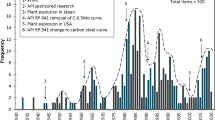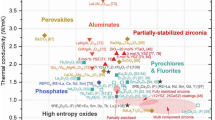Abstract
Erosion–corrosion of engineering materials is encountered in a large variety of engineering applications including thermal power plants. In such environments, boiler steels are widely used, but they often degrade due to erosion–corrosion at temperatures exceeding 500 °C. Superalloys are used at temperatures above 500 °C due to their excellent mechanical properties and creep resistance at high temperature. In the present investigation, the erosion–corrosion performances of nickel- and iron-based superalloys were evaluated in the low temperature primary super heater zone of a thermal power plant. In this zone, the temperature of flue gases was around 540 °C and the samples were exposed to this environment for 10 cycles of 100 h duration. Weight change was measured after each cycle and the erosion–corrosion products were analyzed through SEM/EDAX, XRD and EPMA. All the superalloys showed weight loss, suggesting the contribution of erosion in erosion–corrosion. An interpretation of the erosion–corrosion mechanism is presented.












Similar content being viewed by others
References
J. Stringer and I.G. Wright, Proc. of a Workshop on Wastage of In-Bed Surfaces in Fluidized-Bed Combustors. (EPRI, Palo Alto, CA, 1987), paper 1.1.
J. Stringer, J.W. Stallings and J.M. Wheeldon, in A.M. Manaker (Ed.), Proc. 10th Int. Conf. on Fluidized Bed Combustion. (San Francisco, CA), April 30–May 3, 1989, ASME, New York, NY, pp. 857–862.
J. Stringer, Wear 186–187, 1995 (11–27).
V.H. Hidalgo, F.J.B. Varela and E.F. Rico, Trib. Int. 30, 1997 (641–649).
H.V. Hidalgo, F.J.B. Varela, A.C. Menendez and S.P. Martinez, Trib. Int. 34, 2001 (161–169).
S. Soderberg, S. Hogmark, U. Engman and H. Swahn, Trib. Int. 14, 1981 (333–343).
A.V. Levy, Proc. NACE Conf. Corrosion-Erosion-Wear of Materials in Emerging Fossil Energy Systems. (Berkeley, CA, 1982), pp. 298-376.
A.V. Levy, B.Q. Wang, Y.F. Man and N. Jee, Wear 131, 1989 (39–51).
B. Peterson, D.M. Rishel, N. Birks and F.S. Pettit, Wear 186–187, 1995 (56–63).
R.H. Barkalow and F.S. Pettit, Proc. Conf. Corrosion, Erosion of Coal Conversion System Materials. (Berkeley, USA, 1979), Jan 24–26,1979NACEHoustonTX139173.
C.T. Kang, S.L. Chang, F.S. Pettit and N. Birks, Synergisms in the Degradation of Metals Exposed to Erosive High-Temperature Oxidising Environments,” in G. Simkovich and VS. Stubican (Eds.), Transport in Non-stoichiometric Compounds, (Plenum, New York, 1985), pp. 411-427.
M.M. Stack, F.H. Stott and G.C. Wood, Mater. Sci. Tech. 7, 1991 (1128–1137).
D.J. Stephenson, J.R. Nicholls and P. Hancock, Corros. Sci. 25, 1985 (1181–1192).
D.J. Stephenson, J.R. Nicholls and P. Hancock, Wear III, (15–29), 1986 (31–39).
D.J. Stephenson and J.R. Nicholls, Mater. Sci. Technol. 6, 1990 (96–99).
I.G. Wright, V.K. Sethi and V. Nagarajan, J. Eng. Gas Turbines Power 113, (4), 1991 (616–620).
I.G. Wright, V.K. Sethi and V. Nagarajan, Wear 186–187, (1), 1995 (230–237).
R.J. Link, N. Birks, F.S. Petit and F. Dethorey, Oxid. Met. 49, 1998 (213–236).
B.S. Sidhu and S. Prakash, Sur. & Co. Technol. 166, 2003 (89–100).
G. Kaushal, H. Singh and S. Prakash, Oxid. Met. 76, 2011 (169–191).
G. Kaushal, H. Singh and S. Prakash, Proc. Thermal Spray 2008, DVS-ASM, 2008, pp. 1339-1344.
Y. Li, C. Yuan, J.T. Guo and H.C. Yang, J. Northeastern Uni. 24, 2003 (75–78).
S. Prakash, S. Singh, B.S. Sidhu and A. Madeshia, Proc. Nat. Sem. on Advances in Mat. and Processing, IITR, Roorkee, India, 2001, Nov., 9-10, pp. 245-53.
A.V. Levy, Solid Particle Erosion and Erosion–Corrosion of Materials, ASM Int., (Materials Park, OH 44073-0002, U.S.A), 1995.
A.V. Levy, Cor. Sci. 35, 1993 (1035–1043).
D.M. Rishel, F.S. Pettit and N. Birks: A.V. Levy (eds.), Proc. of Conf. on Erosion–Corrosion-Wear of Mat. at Elevated Temp., NACE, (Houston, TX, 1991) paper no. 16, pp.1-23.
Acknowledgments
The authors wish to thank the Mishra Dhatu Nigam Limited, Hyderabad, India for providing the superalloys; Material Science Division (MMD), BARC, Mumbai, for performing the EPMA analysis; IIT, Kharagpur and IUC Indore, India for extending the facility of SEM/EDAX analysis during this work. The authors are highly grateful to S. G. G. S. Super Thermal Power Plant, Ropar, Punjab, India for their kind support and help to carry out the experimentation work in the power plant environment.
Author information
Authors and Affiliations
Corresponding author
Rights and permissions
About this article
Cite this article
Mishra, S.B., Chandra, K. & Prakash, S. Erosion–Corrosion Behaviour of Nickel and Iron Based Superalloys in Boiler Environment. Oxid Met 83, 101–117 (2015). https://doi.org/10.1007/s11085-014-9509-0
Received:
Revised:
Published:
Issue Date:
DOI: https://doi.org/10.1007/s11085-014-9509-0




